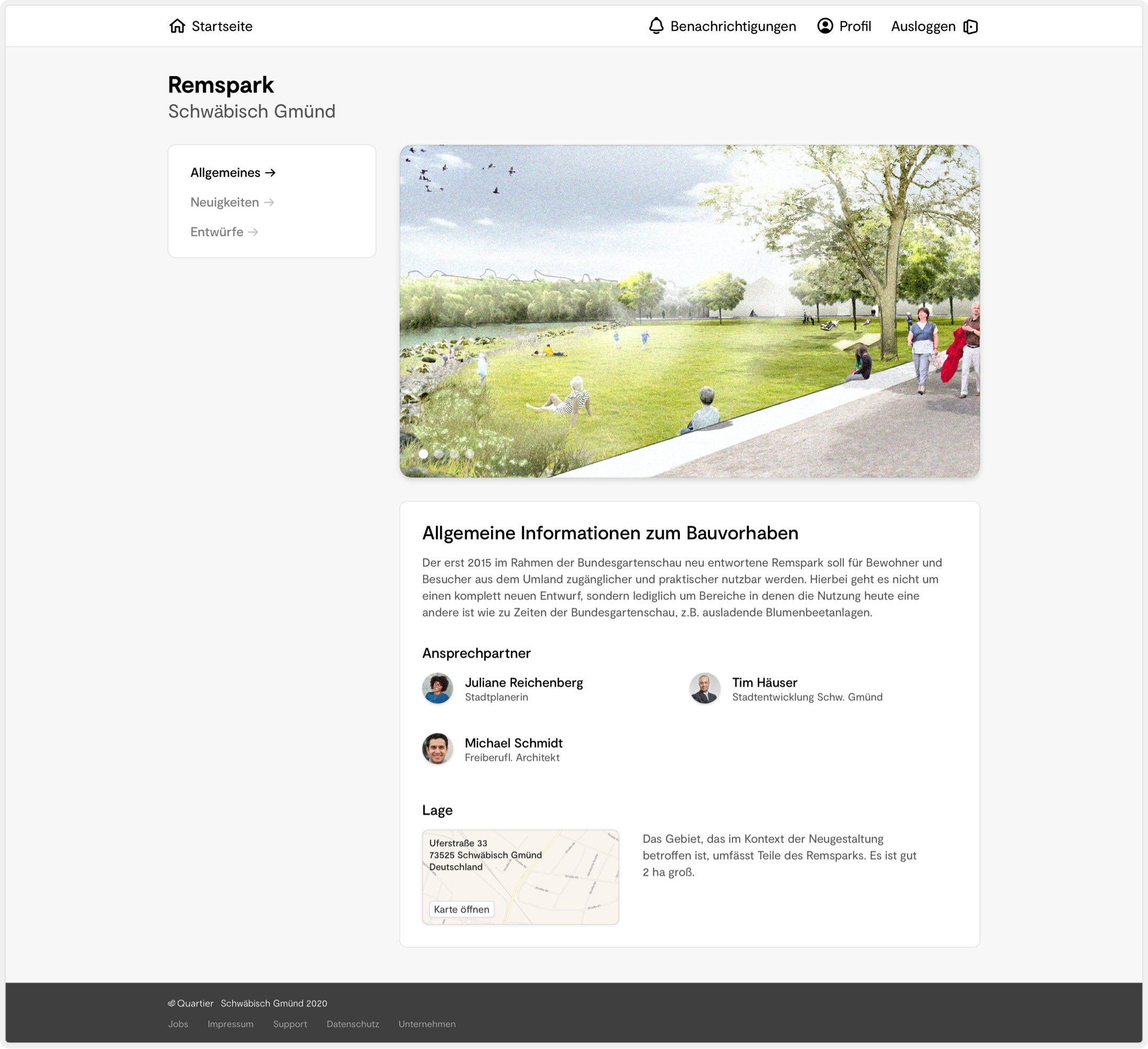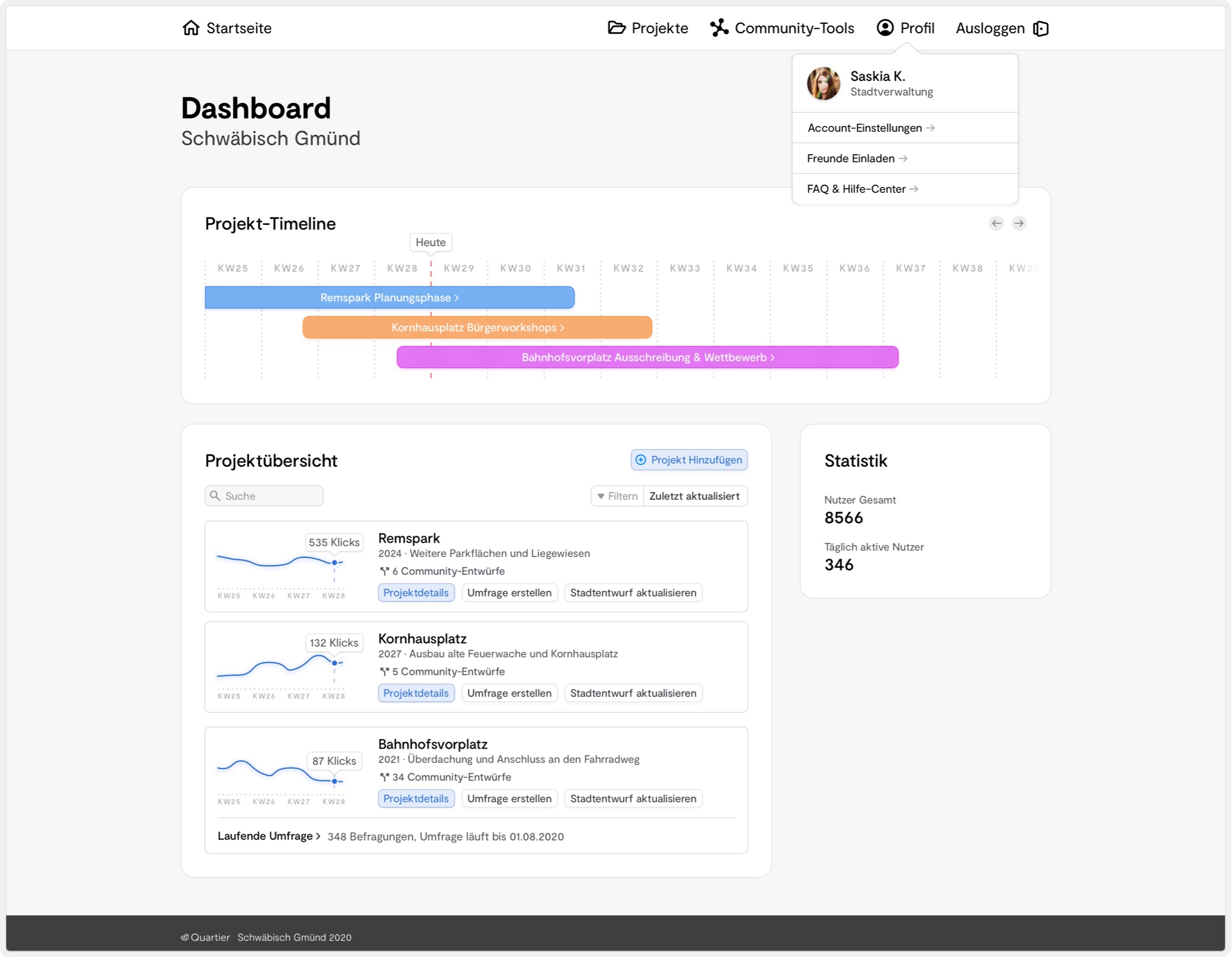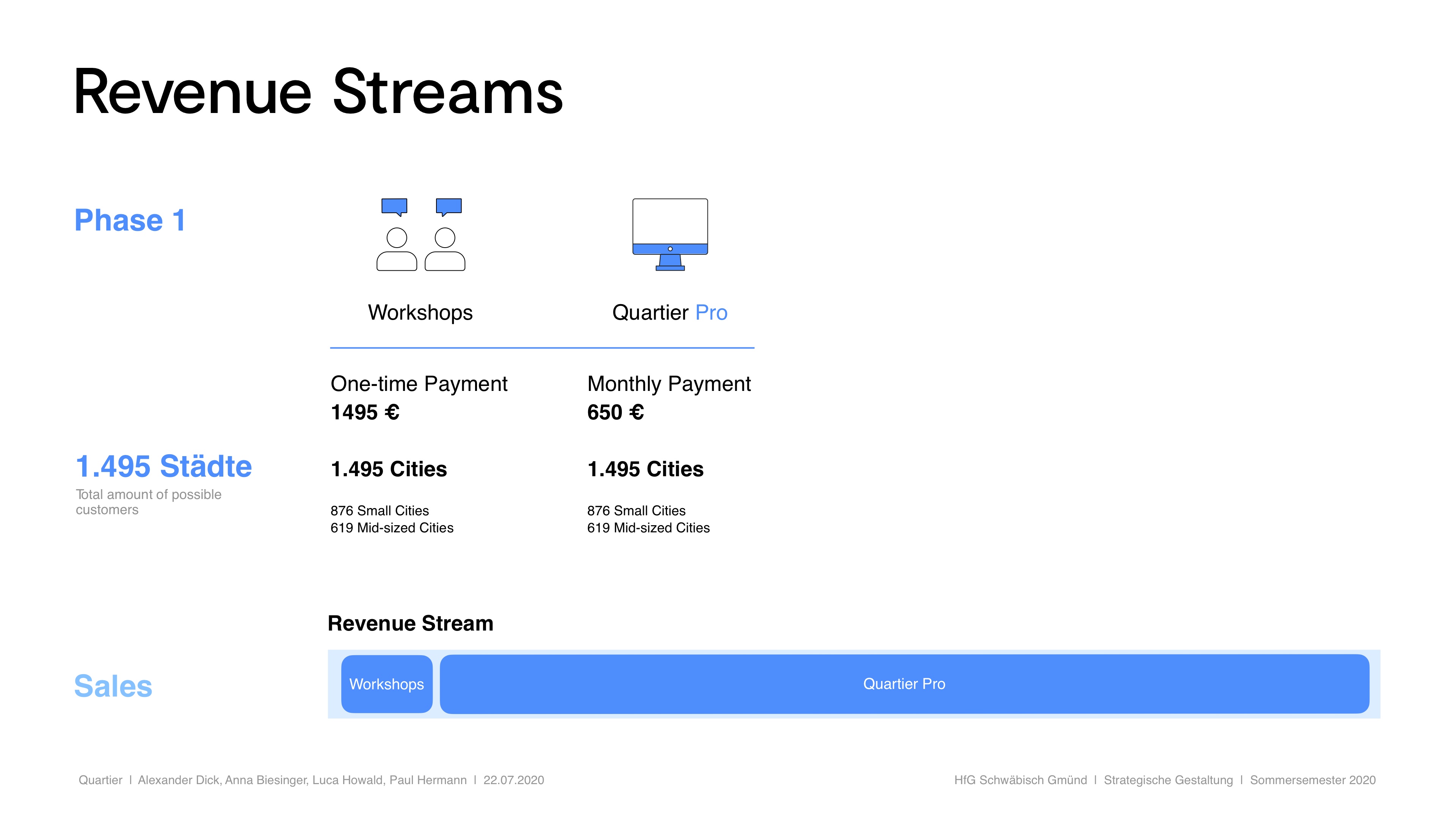Quartier – Creating Livable Cities, Together
Hochschule für Gestaltung Schwäbisch Gmünd — 2020 · Concept, UI & UX
Making a Case For Strategic Design
This project was designed as part of the first semester of the Strategic Design Master Degree. As a team of four students originating from different design backgrounds (communication, interaction and sound/immersive) we started out with this semesters theme "health" and went on from there to find a unique problem to design a solution for. With the theme being loosely held as an anchor point, we committed to healthy societal systems in the specific context of cities.
We conducted dozens of interviews with stakeholders, users and possible customers alike and tried to realistically tackle all the challenges a real world start-up would face.
The first phase (concept and research) was entirely a team effort. Later, we split up into our respective fields of expertise. Among my tasks was the UI & UX design including a high-res prototype as well as the teaser video.
The projects goal was to not only design a solution for the given problem, but to understand the mechanics of an industry that we didn't have any experience with or knowledge in.
Urban Participation: Stakeholder Research
The research for this project was an intense process. Our first step was to screen and talk to professionals from different stakeholders of the industry. We ended up having a team of architects, civil engineers, sociologists, freelancing urban planners as well as people from different city departments. We set up interviews to understand their workflows and the problems they face working on public construction projects.
The goal was to find a problem that was a) worth solving and b) realistically solvable through our skillset. Many of the problem areas we found were far too complex to solve through a consumer product.
Additionally to the interviews, we added SWOT analysis, market and trend analysis. The projects VPC and BMC as well as more on the research process can be found in the documentation at the end of this page.
Defining The Problem
After speaking to our extended team of industry professionals, we worked out three product ideas. We ran them through the BMC and found only one to be economically viable. The solution we propose is a web-based municipal platform to amplify participatory processes of cities any size:
"A strong urban community is a key factor for a healthy and sustainable urban design of the future. Quartier has set itself the task of harnessing the potential of eParticipation for urban development. The products intervene at an early stage in the planning processes of cities and enable a collaborative planning process between citizens and the municipal administrative apparatus."
Product Abstract
The application focuses on information transfer and stimulates communication between citizens and city planners. The idea and goal is to open the black box of a city's planning activities and make all activities publicly accessible. This structural change in the information policy of cities has a lasting participatory effect and forms the basis for all subsequent participatory actions.
In concrete terms, this platform is applied within the framework of existing participatory workshops or information events such as citizens' meetings or local council meetings. The digital nature of the application extends the classic methods of citizen information into the digital space and opens up potential for, for example, particularly busy or restricted citizen groups. It should be noted that the platform is not intended to replace the existing, personal discourse on site, but rather to support it.
Quartier Pro Modulate expands the existing solution with functions with which the citizens themselves are active and the platform becomes the centre of participatory workshops: With the help of an editor, citizens can modify the existing designs of architects and urban planners. Citizens can immerse themselves in the design and change and design the layout and objects. In the process, the user is provided with objects that have already been used and approved by architects. The goal is to make the design experienceable and understandable through interactivity.
One of the most important approaches that we pursue in this product extension is that of conditional design. The nature of urban planning work can be elaborate and complex, and can stand in the way of dialogue between citizens and experts.
When modifying a design, the user should get to know and understand the architect's conditions and compromises. A minimum number of trees or a minimum area of unsealed soil space will give the user an understanding of the conditions of the project. In addition, designs can be created easily and without prior knowledge of CAD. The user has two options:
Parametric design - Using various controls, citizens can quickly and easily adjust the number of individual objects. Our intelligent software automatically places objects in the most sensible locations.
Placing design - Through the integration of an object library, users can place objects individually.
Both functions are proving to be an opportunity for the exchange of architects and citizens to better understand each other's perspectives. The designs can be developed in a moderated workshop or on their own. Our system opens up to a place of joint design and paves the playing field for creative ideas. Functions for rating and favouring designs give the platform a social component and facilitate the quantitative evaluation of the designs.
This product demo (German) is an excerpt from our final presentation pitch.
Visual Design
The visual design of Quartier is calm and content-focussed. As it's destined to be a white-label product, the municipal customers will be able to color and style the UI matching to their existing identity.

Clear and understandable information on construction projects is often overlooked as the first step to enable a nuanced dialogue.
The web-editor gives citizens the ability to experience architecture proposals without expensive software or CAD knowledge.


Using the birds-eye view, users can get an idea of the urban context.

Users can start modifying existing proposals and share them with the community. This way users do not need to start with a blank page.

The platform is not just enabling citizens, but also works as a data source for city counseling.
Setting up a Roadmap and Business Strategy
After we designed our solution, we split up features and mapped out a roadmap to realistically develop the software in an ongoing process. The idea is to ship parts of the software early to continuously build up sales. This way we'd also get feedback as we go and can make sure to adjust our assumptions and product accordingly.




Personal Notes
This project was the exact opposite of »straight-forward«, in a good sense. There were many moments in the concept phase where we all just wanted to say "lets just go with this, we should be fine". And here's the thing: If it was a pure design project like the ones I did in my bachelors, we'd indeed be fine but because of the focus being explicitly put on strategy, we had no choice but to keep adjusting the concept.
Otherwise our proposal would have just fallen apart in the BMC and VPC – it just wouldn't make sense. It had to be waterproof (as waterproof as you can get given the fact that it was a semester project).
Another point I want to stress here is that this project probably was the one with the (intentionally) shortest visual design phase I have ever done. 50% percent of our time went into research and strategy, and 25% into pitching/communicating.
Documentation & Team
A German version of the executive summary of this project can be found here. If you want access to the complete documentation (PDF, 200+ pages) feel free to contact me.
The team was Anna Biesinger (Website, LinkedIn), Luca Howald (LinkedIn), Alexander Dick (LinkedIn) and me. The project was supervised by Prof. Dr. Ulrich Barnhöfer (LinkedIn) and Thomas Schönweitz (LinkedIn).
↑ Go back up
Quartier – Creating Livable Cities, Together
Hochschule für Gestaltung Schwäbisch Gmünd — 2020 · Concept, UI & UX
Making a Case For Strategic Design
This project was designed as part of the first semester of the Strategic Design Master Degree. As a team of four students originating from different design backgrounds (communication, interaction and sound/immersive) we started out with this semesters theme "health" and went on from there to find a unique problem to design a solution for. With the theme being loosely held as an anchor point, we committed to healthy societal systems in the specific context of cities.
We conducted dozens of interviews with stakeholders, users and possible customers alike and tried to realistically tackle all the challenges a real world start-up would face.
The first phase (concept and research) was entirely a team effort. Later, we split up into our respective fields of expertise. Among my tasks was the UI & UX design including a high-res prototype as well as the teaser video.
The projects goal was to not only design a solution for the given problem, but to understand the mechanics of an industry that we didn't have any experience with or knowledge in.
Urban Participation: Stakeholder Research
The research for this project was an intense process. Our first step was to screen and talk to professionals from different stakeholders of the industry. We ended up having a team of architects, civil engineers, sociologists, freelancing urban planners as well as people from different city departments. We set up interviews to understand their workflows and the problems they face working on public construction projects.
The goal was to find a problem that was a) worth solving and b) realistically solvable through our skillset. Many of the problem areas we found were far too complex to solve through a consumer product.
Additionally to the interviews, we added SWOT analysis, market and trend analysis. The projects VPC and BMC as well as more on the research process can be found in the documentation at the end of this page.
Defining The Problem
After speaking to our extended team of industry professionals, we worked out three product ideas. We ran them through the BMC and found only one to be economically viable. The solution we propose is a web-based municipal platform to amplify participatory processes of cities any size:
"A strong urban community is a key factor for a healthy and sustainable urban design of the future. Quartier has set itself the task of harnessing the potential of eParticipation for urban development. The products intervene at an early stage in the planning processes of cities and enable a collaborative planning process between citizens and the municipal administrative apparatus."
Product Abstract
The application focuses on information transfer and stimulates communication between citizens and city planners. The idea and goal is to open the black box of a city's planning activities and make all activities publicly accessible. This structural change in the information policy of cities has a lasting participatory effect and forms the basis for all subsequent participatory actions.
In concrete terms, this platform is applied within the framework of existing participatory workshops or information events such as citizens' meetings or local council meetings. The digital nature of the application extends the classic methods of citizen information into the digital space and opens up potential for, for example, particularly busy or restricted citizen groups. It should be noted that the platform is not intended to replace the existing, personal discourse on site, but rather to support it.
Quartier Pro Modulate expands the existing solution with functions with which the citizens themselves are active and the platform becomes the centre of participatory workshops: With the help of an editor, citizens can modify the existing designs of architects and urban planners. Citizens can immerse themselves in the design and change and design the layout and objects. In the process, the user is provided with objects that have already been used and approved by architects. The goal is to make the design experienceable and understandable through interactivity.
One of the most important approaches that we pursue in this product extension is that of conditional design. The nature of urban planning work can be elaborate and complex, and can stand in the way of dialogue between citizens and experts.
When modifying a design, the user should get to know and understand the architect's conditions and compromises. A minimum number of trees or a minimum area of unsealed soil space will give the user an understanding of the conditions of the project. In addition, designs can be created easily and without prior knowledge of CAD. The user has two options:
Parametric design - Using various controls, citizens can quickly and easily adjust the number of individual objects. Our intelligent software automatically places objects in the most sensible locations.
Placing design - Through the integration of an object library, users can place objects individually.
Both functions are proving to be an opportunity for the exchange of architects and citizens to better understand each other's perspectives. The designs can be developed in a moderated workshop or on their own. Our system opens up to a place of joint design and paves the playing field for creative ideas. Functions for rating and favouring designs give the platform a social component and facilitate the quantitative evaluation of the designs.
This product demo (German) is an excerpt from our final presentation pitch.
Visual Design
The visual design of Quartier is calm and content-focussed. As it's destined to be a white-label product, the municipal customers will be able to color and style the UI matching to their existing identity.

Clear and understandable information on construction projects is often overlooked as the first step to enable a nuanced dialogue.

The web-editor gives citizens the ability to experience architecture proposals without expensive software or CAD knowledge.

Using the birds-eye view, users can get an idea of the urban context.

Users can start modifying existing proposals and share them with the community. This way users do not need to start with a blank page.

The platform is not just enabling citizens, but also works as a data source for city counseling.
Setting up a Roadmap and Business Strategy
After we designed our solution, we split up features and mapped out a roadmap to realistically develop the software in an ongoing process. The idea is to ship parts of the software early to continuously build up sales. This way we'd also get feedback as we go and can make sure to adjust our assumptions and product accordingly.




Personal Notes
This project was the exact opposite of »straight-forward«, in a good sense. There were many moments in the concept phase where we all just wanted to say "lets just go with this, we should be fine". And here's the thing: If it was a pure design project like the ones I did in my bachelors, we'd indeed be fine but because of the focus being explicitly put on strategy, we had no choice but to keep adjusting the concept.
Otherwise our proposal would have just fallen apart in the BMC and VPC – it just wouldn't make sense. It had to be waterproof (as waterproof as you can get given the fact that it was a semester project).
Another point I want to stress here is that this project probably was the one with the (intentionally) shortest visual design phase I have ever done. 50% percent of our time went into research and strategy, and 25% into pitching/communicating.
Documentation & Team
A German version of the executive summary of this project can be found here. If you want access to the complete documentation (PDF, 200+ pages) feel free to contact me.
The team was Anna Biesinger (Website, LinkedIn), Luca Howald (LinkedIn), Alexander Dick (LinkedIn) and me. The project was supervised by Prof. Dr. Ulrich Barnhöfer (LinkedIn) and Thomas Schönweitz (LinkedIn).
↑ Go back up